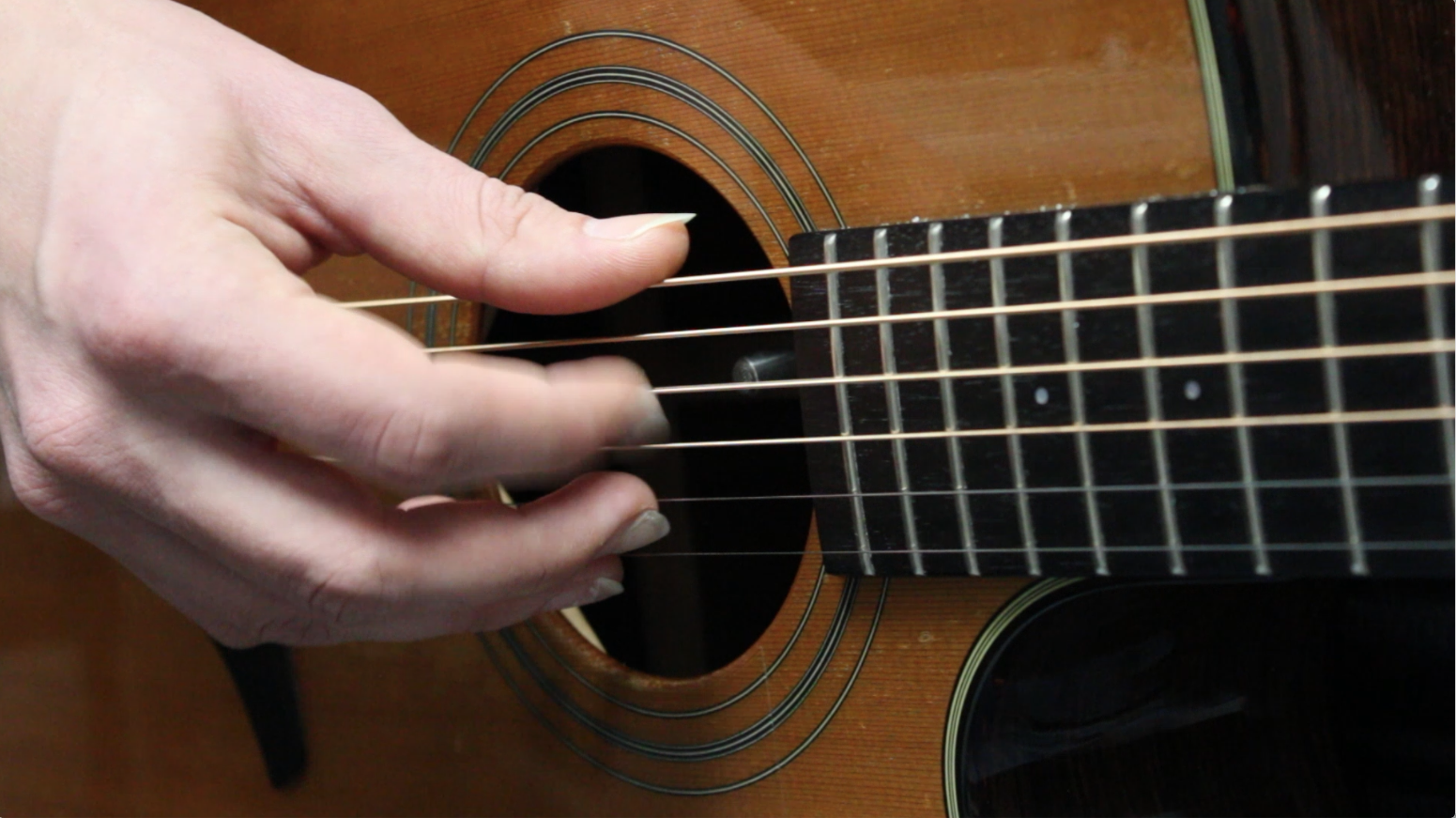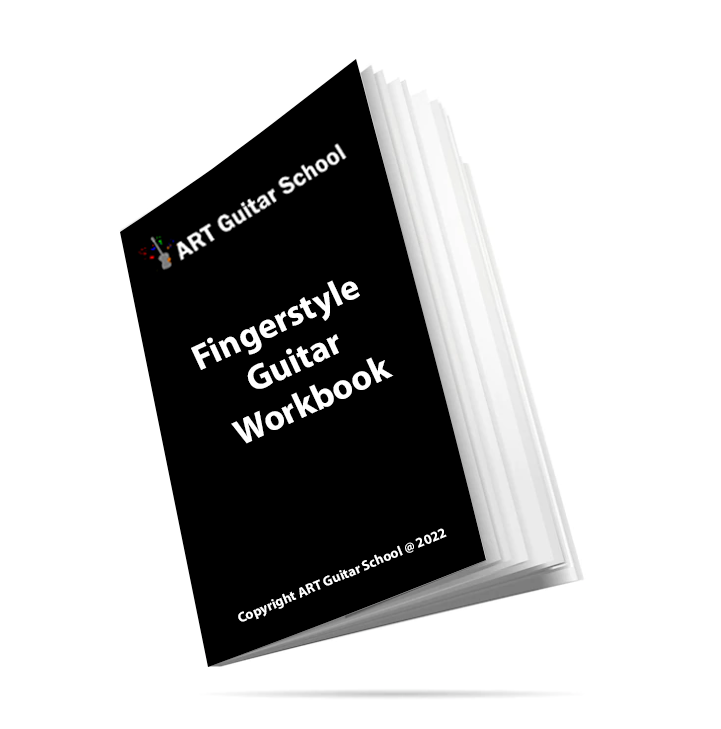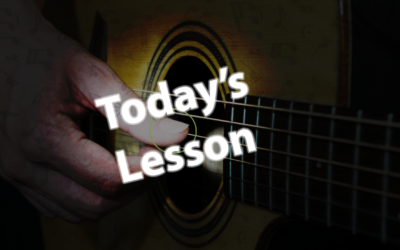FINGERPICKING KEY

The right hand:
P = Thumb
I = Index
M = Middle
A = Ring
Fingerpicking Pattern No. 1
This is the most essential fingerpicking pattern to start with. It requires no left hand chord or fretted notes. It is used in many popular fingerpicking songs and some songs are slight variations of this same pattern.
We have all open strings being plucked in sequential order. Each note is a quarter note in duration and will last exactly one second each if played at 60bpm.
Lets get to playing!
We will pluck each open string in order starting from the 6th string (Low E) and ending on the 1st (High E).
Step 1. Lets start with thumb (p) and pluck the 6th-4th string
Step 2. Pluck index (i), middle (m) and ring (a) on the 3rd-1st strings.

Here is a video demonstration of the finger picking pattern:
If you were having trouble please contact us and we will help you!
FOLLOW US ON
Get our FREE Fingerstyle Workbook!
RELATED BLOG POSTS
How to Incorporate Percussive Elements in Fingerstyle Playing
Incorporating percussive elements into fingerstyle guitar can add a dynamic and engaging layer to your playing. This technique not only enhances your sound but also creates a rhythmic backbone that complements melodic lines. Here are some effective methods to integrate percussive elements into your fingerstyle technique.
1. Palm Muting: One of the simplest ways to add a percussive effect is through palm muting. By lightly resting your palm on the strings near the bridge while you pluck, you can create a muted sound that mimics a drumbeat. Experiment with varying the pressure of your palm to achieve different tones.
2. Body Percussion: Use your guitar’s body as a percussion instrument. You can tap on the top or sides of the guitar with your fingers or palm. This technique can be combined with fingerpicking patterns to create an intricate, layered sound.
3. Slap Technique: Similar to slap bass, this technique involves striking the strings with your thumb while simultaneously plucking other strings with your fingers. This creates a sharp, rhythmic sound that can enhance the groove of your piece.
4. String Muting: Use your left hand to mute strings after plucking them. This creates a staccato effect that can add rhythm and texture to your playing. Experiment with different muting techniques to see how they change the feel of your music.
5. Incorporate Rhythmic Patterns: While fingerpicking, integrate specific rhythmic patterns that mimic drumming. You can alternate between plucking strings and creating percussive sounds, allowing you to develop a unique style.
6. Use Open Strings: Incorporate open strings in your percussive playing. By allowing certain strings to ring while muting others, you create a contrast that adds depth to your sound.
7. Practice with a Metronome: To ensure that your percussive elements remain in time with your melody, practice with a metronome. This will help you develop a consistent rhythm, allowing you to seamlessly blend percussive sounds with melodic lines.
8. Explore Different Styles: Listen to fingerstyle guitarists known for their percussive techniques, such as Tommy Emmanuel or Andy McKee. Analyzing their styles can provide inspiration and ideas for incorporating similar elements into your own playing.
Incorporating percussive elements into fingerstyle guitar not only enriches your sound but also enhances your rhythmic skills. With practice and experimentation, you can develop a distinctive style that captivates your audience and showcases your creativity.
Fingerstyle vs. Flatpicking: Pros and Cons
When it comes to guitar playing, two prominent techniques often debated are fingerstyle and flatpicking. Each has its unique strengths and characteristics, making them suited for different styles and preferences. Let’s explore the pros and cons of each technique to help you decide which might be the best fit for your musical journey.
Fingerstyle Pros:
Expressive Tone: Fingerstyle allows for greater dynamic range. By using your fingers, you can produce softer, more nuanced tones and easily vary your volume.
Complex Arrangements: This technique enables guitarists to play melody and harmony simultaneously. Fingerstyle players can incorporate bass lines, melodies, and chords, creating intricate arrangements.
Versatile Styles: Fingerstyle is prevalent across various genres, including folk, classical, and blues, allowing you to explore a wide range of musical possibilities.
Fingerstyle Cons:
Steeper Learning Curve: Fingerstyle can be challenging for beginners. Coordinating fingers for different strings requires practice and patience.
Limited Speed: While skilled fingerstyle players can achieve impressive speed, it often takes longer to reach high velocities compared to flatpicking.
Flatpicking Pros:
Speed and Precision: Flatpicking, using a pick, generally allows for faster playing, making it ideal for bluegrass and rock genres where speed is essential.
Ease of Learning: For many beginners, flatpicking feels more intuitive. Holding a pick can be easier than coordinating multiple fingers, leading to quicker initial progress.
Strumming Capabilities: Flatpicking is excellent for strumming chords, making it a versatile technique for rhythm guitar playing in various styles.
Flatpicking Cons:
Limited Dynamics: While flatpicking can produce a strong sound, it may lack the subtlety and dynamic range that fingerstyle offers.
Less Complexity: While you can play melodies with a pick, combining melody, harmony, and bass lines in the same way as fingerstyle is more challenging.
In conclusion, both fingerstyle and flatpicking have their unique benefits and drawbacks. The best choice depends on your musical goals and personal preferences. Whether you lean towards the intricate beauty of fingerstyle or the swift efficiency of flatpicking, mastering either technique will enhance your overall guitar skills.
Developing a Consistent Fingerstyle Rhythm
Developing a consistent fingerstyle rhythm is essential for any guitarist looking to enhance their musical expression and technical skills. A solid rhythmic foundation allows you to play more complex patterns and syncopations with ease. Here are some effective strategies to help you achieve a reliable fingerstyle rhythm.
1. Understand the Basics of Rhythm: Start by familiarizing yourself with basic rhythmic concepts, including beats, measures, and subdivisions. Learning to read sheet music or tablature can be beneficial, as it provides a visual representation of rhythms.
2. Use a Metronome: Practicing with a metronome is one of the most effective ways to develop rhythmic consistency. Begin at a slow tempo, focusing on playing each note precisely in time with the metronome’s clicks. Gradually increase the speed as you become more comfortable.
3. Break Down Patterns: Take complex fingerstyle patterns and break them into smaller, manageable sections. Practice each segment slowly, ensuring that you maintain a steady rhythm. Once you feel confident, gradually piece them together, always keeping the metronome in mind.
4. Incorporate Dynamics: Dynamics play a vital role in fingerstyle rhythm. Practice varying your attack on different strings; pluck some notes lightly and others with more force. This will help create a more engaging and expressive sound.
5. Experiment with Different Fingerpicking Patterns: Explore various fingerpicking patterns, such as Travis picking, arpeggios, or alternating bass lines. Each pattern has its unique rhythmic feel, and experimenting with them will enhance your overall rhythmic versatility.
6. Play Along with Music: Find songs that utilize fingerstyle techniques and play along. This practice helps you internalize rhythms and develop your timing. Start with simple pieces, gradually moving to more complex songs as your skills improve.
7. Record Yourself: Recording your practice sessions can provide valuable insights into your rhythm. Listening back allows you to identify areas that need improvement, helping you stay accountable to your progress.
8. Stay Relaxed: Tension can lead to a loss of rhythm. Make sure to stay relaxed while playing. Take breaks if you feel tense, and shake out your hands and fingers to release any built-up tension.
With dedication and consistent practice, developing a reliable fingerstyle rhythm will enhance your overall guitar playing. Remember, rhythmic precision is a skill that takes time to cultivate, so be patient with yourself as you progress.




0 Comments